Midway through repotting a procumbens juniper, I found that the center of the rootball was dry. This is common when a tree has gone too long without repotting. Even heavy and frequent waterings – or incessant rain – may not be enough for the water to soak the entire rootball.
Rootball with dry center
Finding dry patches of soil during repotting is great as addressing the problem is easy. Bare-rooting sections of the rootball is one option for improving water’s ability to pass through the soil. Another is creating holes in the rootball.
Creating holes with a root hook, chopstick or old screwdriver loosens up the rootball enough to let water pass by more roots during watering and makes it easier for water to soak into the remaining compacted areas. For this tree, I used a root hook to create a hole.
Using a root hook to perforate the rootball
I worked from the top of the rootball and the bottom until I’d removed a section of soil about 1.5″ across.
A hole in the rootball
I made several similar holes around the rootball, being careful not to damage too many of the exposed roots in each hole.
After preparing the rootball for repotting, I tied the tree into the pot and began adding soil.
Rootball secured into the pot
This is where it can be helpful to remember where the holes were created. I filled each hole with loose soil and used chopsticks to settle the new soil into place.
Hole filled with bonsai soil
After settling the soil in the holes, the level of the soil dropped a bit so I added more soil and repeated the process until the holes were full of fresh soil.
After settling the soil in the hole
After refilling and resettling the soil
When the chopstick work was complete, I mounded some soil above the rootball and tapped it into place. Here’s the tree freshly repotted.
Procumbens juniper after repotting
As noted in the previous post, the new pot isn’t perfect, but it’ll do well as I continue to refine the tree. I expect I’ll tilt the tree further to the right at the next repotting, but hesitated as I didn’t want too much of the rootball to rise above the edge of the pot as I’d already removed a number of roots during this repotting.
I’ll let the tree settle into the new pot for several months and then get to work on the foliage. Feeding will begin in about a month.
Subscribe to Bonsai Tonight
New Posts Delivered Every Tuesday and Friday

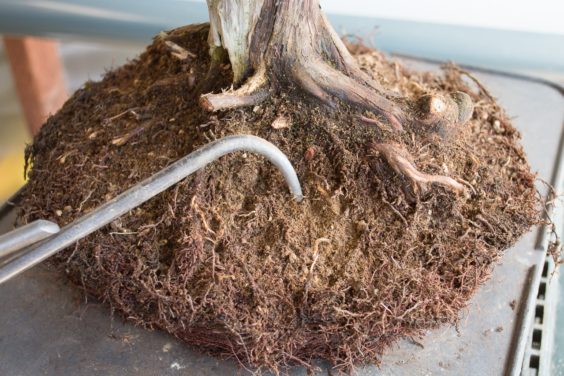
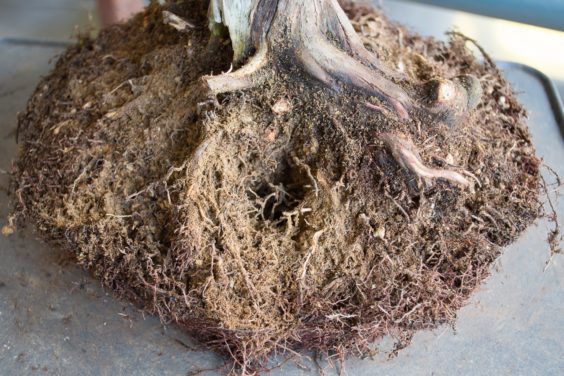
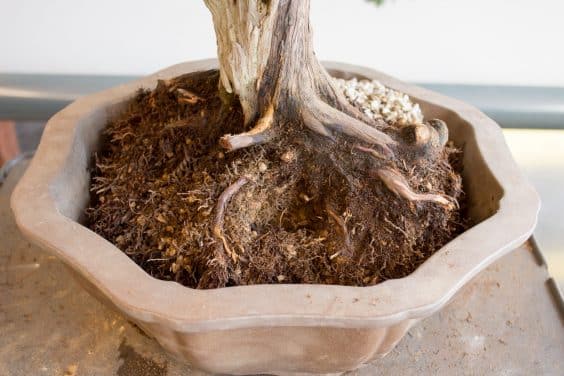
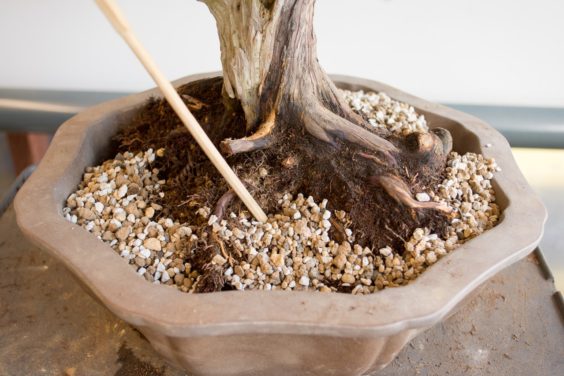
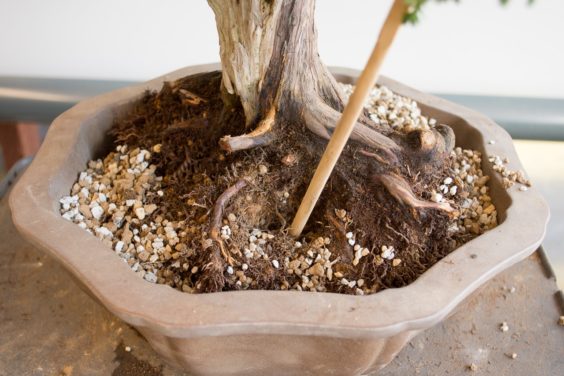
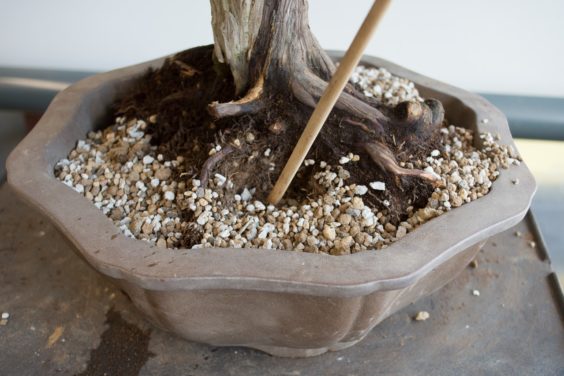
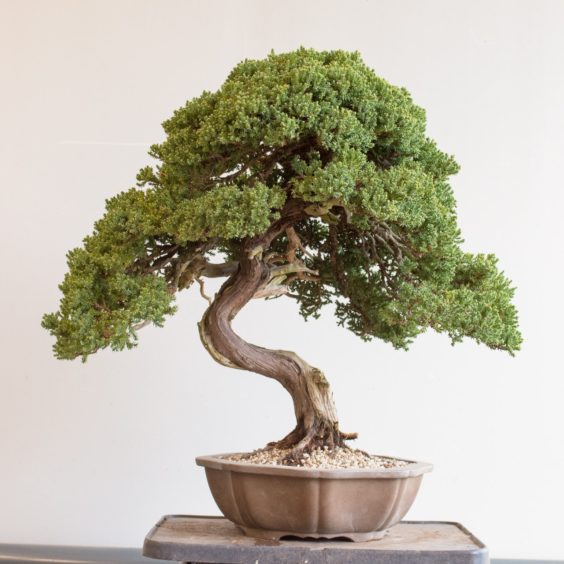
John C DeMaegd says
I have to ask why you wouldn’t dive into the compacted rootball more to loosen it up and create a more open root system to allow thorough drainage? Would this be too much disturbance?
Jonas Dupuich says
Good question – much of the rootball was fine. I put the holes where the soil was most compacted which should help get water to the whole rootball.
Little tree says
Great tips regarding both section bareroot and hole technique. I think both of these techniques are nice in that they clean by removing old soil and damaged/ dead roots. The other technique commonly used, is to use sticks to perforate sections of the rootball. Although this technique is less invasive per se, it leaves damaged roots and potentially crushed soil (i.e. Kanuma) in place. Any insights to using one technique over another and when?
Jonas Dupuich says
The perforation approach is good if the soil isn’t too bad and it loosens the rootball. Removing more old soil is best when the soil is really compacted.
Little tree says
BTW I commonly use the stick technique, but always wonder about my comment above.
Charlie Mosse says
I just repotted 2 nanas that I purchased at the end of October. The rootballs were so old and tired that watering, even slow dripping, only watered about 20% of the ball. I knew they were way beyond needing new soil but this was crazy. When I cut the bottom half of the root ball off, it was two-toned. The #2 pot sized root ball had about 1/2 ” of moist “soil” around the perimeter of the root ball, 1/4″ on the top of the rootball and the bottom and the rest of the interior was bone dry. Needless to say, the nana did not respond much after being pruned even with good fall weather here in San Diego. New spring growth was just as weak. Could not completely “renovate” the rootball this time as the weather is warming quickly. I will complete the root ball work at the next repot. Did the same work as in your photos, so I feel comfortable with what was done.
Can’t wait to see when the foliage work starts. Thx
Ann Mudie says
In days gone by one method was to take ‘wedges’ out. You didn’t even consider this though – is removing ‘wedges’ not a good way to work anymore?
Jonas says
Hi Ann – removing a wedge of soil is still a great strategy for removing bad soil. As the compacted soil was closer to the middle of the rootball, I opted for the approach that got at the most compacted bits. Taking a wedge would have worked but it would have meant removing more soil than was necessary.
Chris says
Nice article. I was wondering the root ball could be “touched” even if we are not repotting. Can you poke some new holes to loosen the root ball in a couple of months or so you don’t have to wait till the next repotting to work on the roots?
Jonas Dupuich says
Hi Chris – yes, holes can be poked in the rootball between repottings to improve drainage. Even better, the top of the soil can be removed and replaced with fresh soil that will allow water to pass through.
Leonard Bell says
Very good instructional. I have seen hard compacted roots like this before and wondered what was to be done. If you had done nothing, what would have happened with a large planting like this one?
My question also concerns the material removed. As dry and lifeless as the material looked, removing it shouldn’t have stressed the tree that much should it? If it was even more dry would you have removed more, or let it recover and remove more at a later date ( how long )?
Will the addition of the new pockets of soil stimulate new feeder roots as well?
Jonas Dupuich says
Hi Leonard – good question! If I’d done nothing, I’d expect the tree to get weaker, be more susceptible to infestation, and eventually lose branches.
Removing so little soil will not significantly stress the tree and it will encourage the tree to produce new roots quickly in the new soil. If more of the soil were compacted I would have removed more of it by bare-rooting pie-slices or a full half of the rootball. This work can be stressful for the tree but it allows it to recover and produce the fine roots needed for continued health.
Leonard Bell says
Jonas,
How does the stress of doing nothing compare to the removal and root recovery?
Could you have soaked the root ball ( perhaps in root stimulator and water ?) and worked it till the entire mass was relieved? Once all the roots were bared, you could select out the dead material and make even more room for new growth?
Regards
Jonas Dupuich says
Hi Leonard – the stress of doing nothing can lead to dieback and death over time. The stress of exposing roots is generally offset by facilitating new root growth. In some cases exposing roots can reduce the amount or character of new growth in the year of the repotting, but produce more growths following year.
Washing all of the soil away is overly stressful for conifers.
Soaking the rootball in summer can be a good way to ensure water reaches the roots when the drainage is poor.